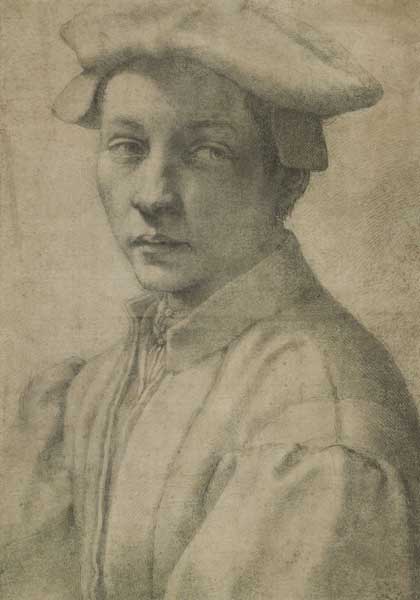Great Works: Portrait of Andrea Quaratesi c.1528-32 (411 x 292 mm), Michelangelo Buonarroti
British Museum, London

Michelangelo was profoundly ill at ease with himself and the world. You can glimpse this heightened degree of psychological agitation by the way he so often treats his materials, wrenching and pulverising them, ever impossibly demanding. Think, for example, of those multiple studies, drawn, painted or sculpted (there could never be too many studies), of naked male bodies in extreme, muscular postures, as if seeking to outdo themselves. There is little calm about this world of his. Nothing has come to rest – nor will it ever do so, we feel.
It is therefore perfectly understandable that Michelangelo should have produced so few drawn portraits during his lifetime. Human beings were simply not perfect enough for his attentions. They were a touch too humdrum in their common humanity. Except, perhaps, for an exquisite two or three, amongst whom we must surely number the young Andrea Quaratesi, the subject of this study. In mood and character, this painstakingly tender and attentive drawing in chalk feels set apart from much of the rest of what we know of Michelangelo. The monster has, momentarily at least, stopped roaring. It does not seek to heroicise its subject. It is as if he has gently settled back down on Earth, and is once again a mortal amongst other mortals. Yes, the miracle of this drawing lies in the fact that it is both exquisitely beautiful and exquisitely ordinary. Clothes apart, there is nothing much here other than the unadorned splendour of this boy's lovely humanity.
The subject was the son of a family of Florentine bankers who may have protected the artist during politically turbulent times. Michelangelo is also said to have given the boy drawing lessons. What age is he? Perhaps a little under 20 – or younger still. It is quite difficult to judge. He is evidently burgeoning. We see that from the gentle plumping of his lips and much else. The young man stands side on to us, his face twisted to the left, as if mildly surprised to be observed, almost caught out. He is richly, fashionably dressed – but not excessively so. His clothes do not overwhelm his character. And yet they do plump out his physique – admire, for example, the shapeliness of those shoulders, and how they are made so by the cut of the padded and pleated garment that he is wearing. The clothes seem to suggest that he is a touch older and more mature than the vulnerable, boy-like creature who inhabits them. The collar is crisply upright, as if endowing the neck with the authority of adulthood. The boy resides in that comical bristle of nape hairs. The left shoulder faces us, almost pushes back against us, as if to say: a little distance, please. Although these clothes help to define him physically – in fact, we could truthfully say that they put years on his back – they do not really control how we feel about him. There is a sweetness, a touching, alluring douceur in that look of his. There is wariness too. Michelangelo has emphasised the beauty of irises and pupils by making the eyes slightly bulbous, as if magnified by the overwhelming attraction of the artist's gaze. The drawing is in black chalk, which adds to a sense of modesty and restraint. No single element rasps or blares back at us. The drawing – we see upper torso and head – is surprisingly large and imposing: about two-thirds life size. Michelangelo must have been standing breathingly close to his subject when he made it nearly 500 years ago. The chalk marks – we see them quite clearly – are tiny strokes, hundreds of them.
What is this drawing saying to us? Well, it seems to be lamenting the early passing away of such youthful beauty – this is a subject which Michelangelo had also addressed in his poems. We must bear in mind, too, that he was about 18 or so years the boy's senior when he made this work. He might have been remembering himself. Had he been quite so beautiful at this age? No, perhaps not.
ABOUT THE ARTIST
Regarded by many as the greatest artist of the Italian Renaissance, Michelangelo Buonarroti (1475-1564) was extraordinarily accomplished as a painter, sculptor and architect. He also wrote a considerable body of fine poetry. His jealous, tempestuous nature is almost as legendary as his great works, which include his statue of 'David', which is on display in the Accademia, Florence (a replica of the same statue stands outside the Palazzo Vecchio), his 'Pietà' in the Vatican Museums, Rome, and his decorative schemes for the Sistine Chapel. He seldom gave away his drawings. In fact, he hoarded them with the utmost secrecy lest lesser rivals steal his ideas. This drawing is one of a batch acquired by the British Museum directly from the Buonarroti family later in the 19th century.
Subscribe to Independent Premium to bookmark this article
Want to bookmark your favourite articles and stories to read or reference later? Start your Independent Premium subscription today.

Join our commenting forum
Join thought-provoking conversations, follow other Independent readers and see their replies